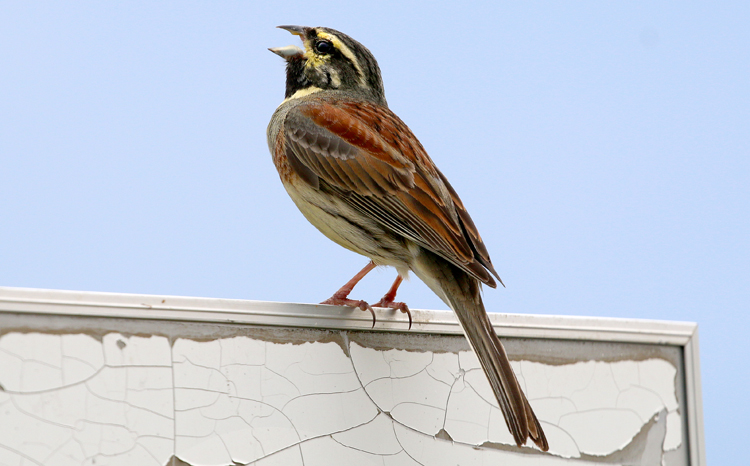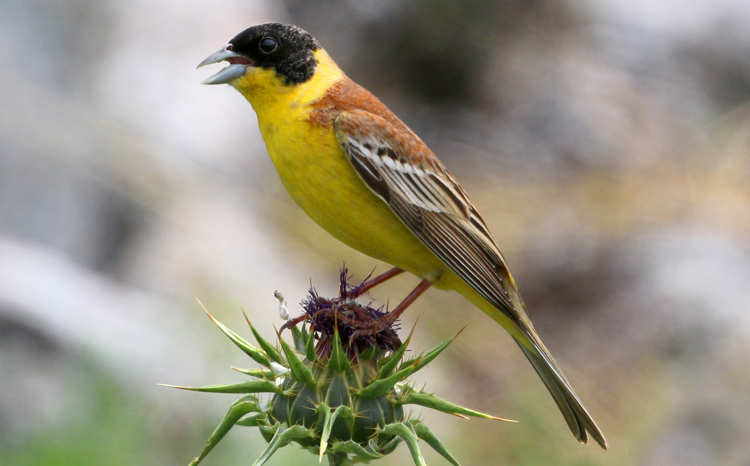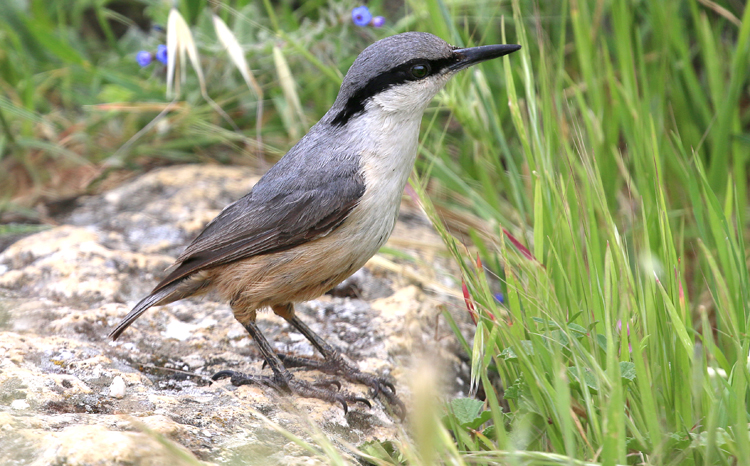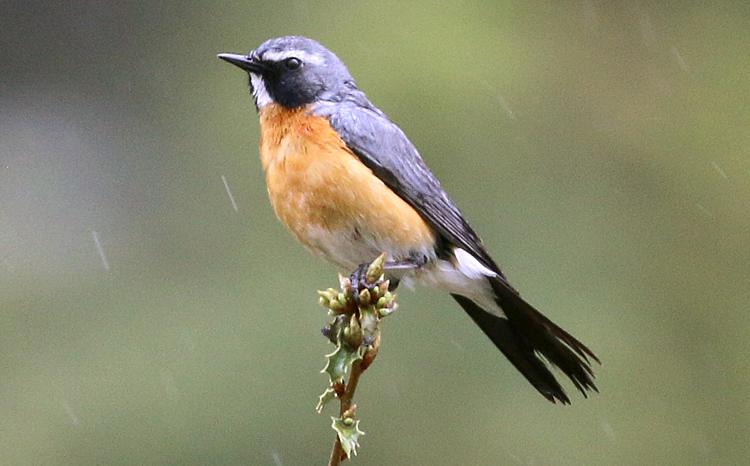
A great week in south-west Türkiye, with a few mega-targets achieved: White-throated Robin, Finsch's Wheatear, Olive-tree Warbler & Black-headed Bunting, plus other nice eastern species and some cool archaeology.
Return to trip reports

















eared Wheatear
(form pencillata)






























Night Heron
May 1st
A sensible departure time for the longish drive to Luton airport, and then an irritating near two-hour delay, but Easyjet eventually got us to Izmir by about 2100 local time. Car collected and away into the night, via the briefest of owls almost colliding with the windscreen (unidentifiable beyond “it was brown and it was impossible to judge the size”) and a random alcohol breath test on the motorway! Arrived at the very suitable Opus Apart Hotel by 2300 or so, and had a decent, if shorter than desirable, night’s sleep.
May 2nd
Up and at ‘em at 0630, and a straight off to Azap Gölü, via drive-by Red-rumped Swallows and various other common Mediterranean birds. Our target site was a lovely, reed-fringed lake, with a few Dalmatian Pelicans mooching about, Great Reed Warblers gronking in every patch of reed, a couple of fleeting Little Bitterns, a flyover Long-legged Buzzard, and a small flock of dainty White-winged Terns dipping down to the lake’s surface. We also found a small colony of Sacred Orchids, a new one for us.
Next, it was on to the eastern end of Bafa Gölü, just a short distance to the south. Views of the lake itself were difficult, but activity was greatest around the tamarisks, reeds, pools and muddy margins anyway, so no problem! The immediate impression was that this was Mediterranean Gull city – over 1000 summer-plumaged adults fed noisily over the fields and tamarisks! Other highlights here were several Ruddy Shelduck, a very few Greater Flamingoes, a Spur-winged Lapwing, a few Pygmy Cormorants, a cracking male Penduline Tit, and many noisy Eastern Olivaceous Warblers, one of which finally gave himself up for good views! Also here was a stunning black Rock Agama lizard, and a sizeable Spur-thighed Tortoise rescued from the road.
With provisions gathered, we headed west via Akköy to the delta of the River Meander. Sadly, few places held significant fresh water, but we did find Squacco Heron, lots of Wood Sandpipers and a Ruff, Spanish Sparrow and more, and briefly enjoyed the ruins of the Greek city of Miletus, cloaked in a super-abundance of wild flowers.
Further west, we followed the road along the southern edge of the Büyük Menderes National Park, a vast rocky peninsula jutting out west towards Samos. We shared an excellent cave picnic spot with a brief Western Rock Nutchatch, and added Whimbrel, Oystercatcher, Blue Rock Thrush and Short-toed Eagle to the list. The plants were again spectacular, and included both Tassel Hyacinth and the highly-endemic Campanula tomentosa, which Simon correctly failed to identify from the book, because it isn’t in our book.
It was now hot and we were tired, so we headed for home, via a showy male Masked Shrike on wires. A minor bump (with no structural damage) from the car behind at some traffic lights was annoying rather than catastrophic. To be cleaned before returning the car, we think (it was!).
Julia was bushwhacked, but Simon gave it another hour around the local scrubby hill: fairly scant rewards in an urban setting, but he did find Crown-flower (Artedia squamata) and many robust Pyramidal Orchids, two singing Eastern Olivaceous Warblers, and a welcome female Red-backed Shrike. Early bedtime tonight!
May 3rd
Up and away early for the 2.5 hour drive east to the Denizli area. We turned off the motorway at around 1000, and reached the lovely, colourful mountain village of Babadag for a cold drink and a break, with hirundines and swifts overhead. Onwards we went, up through cool pine forests, and found the turning for the wind turbine access road with no difficulty.
The track was very rough but well graded, and we saw no-one apart from four maintenance workers dealing with one of the giant turbines. Birds were, of course, thin on the ground, but it was all about quality today, and we scored early with the first of many Northern Wheatears, and surprisingly quite numerous, high-altitude Tawny Pipits. At the last turbine (1875m) we stopped and worked our way back in smaller steps, with frequent stops. The sub-highlight up here was a singing male Ortolan Bunting, but the undoubted stars were three (Anatolian) Horned Larks, of the hyper-distinctive (and surely a split!) form pencillata. Absolutely amazing birds. We rounded off the mountain top list with Red-billed Chough, Short-toed Eagle and Long-legged Buzzard, and then descended to the tree-line for lunch.
Here, we quickly scored with a very brief Sombre Tit, plus Red-backed and Woodchat Shrikes, and shortly after, a male Krüper’s Nuthatch did his thing, very energetically and not very close by, in the woodland edge. Also here were Steppe Buzzard, Woodlarks, European Serins and a Cirl Bunting.
Further down in the woods, a couple of “on-spec” stops did the trick – the first turning up another Spur-thighed Tortoise, Nettle-tree Butterfly and an absolutely belting displaying male Krüper’s Nuthatch, and the second successfully nailing Eastern Bonelli’s Warbler in song (and calling), along with (Anatolian) Coal Tits.
Another cold drink in Babadag on the descent, and then down through the amazing dissected hillsides towards Denizli, via a purple patch featuring Bee-eaters, Hoopoes, Woodchat Shrike and a Syrian Woodpecker. A few Rollers decorated the wires on the way in to Denizli. While our remote and rather grand business hotel is on the outskirts (deliberately and well chosen), we managed to miss the slip road not once but twice, and ended up with an intimate knowledge of the northern city bypass system.
We saw Lesser Whitethroat, Cirl Bunting and Red-backed Shrikes very locally before room service and wine, and bed. A long day!
May 4th
Local sites today – yay! We set off at 0730 and successfully reached the northern entrance of the Hierapolis World Heritage Site just as it was about to open – first people in! We had a fabulous quiet walk through the necropolis of the ancient Greek city, along the old main street to the main ruins, with a stunning theatre, thermal baths (housing a small and interesting museum) and even a plutonium (a sunken temple where bulls were sacrificed by suffocating them in the carbon dioxide escaping from the hot springs. Pre-scientific cult members must have marvelled at how an animal died with no visible cause – clearly the god of the underworld simply extinguished their lives. Dark, but fascinating. Also, we thoroughly enjoyed the astonishing travertine “pools” (actually very few of them had water in them) which cascaded down the hillside to the village of Pamukkale (which means “cotton candy” in Turkish!). A truly wonderful place, even before you consider the birds.
And the birds were even better! We started off with point blank Western Rock Nuthatch and Eastern Black-eared Wheatear at the gate, and followed up swiftly with Alpine Swift, many Red-rumped Swallows, Red-billed Chough and an Ortolan Bunting. Cirl Bunting, Spotted Flycatcher, Eastern Olivaceous and Orphean Warblers soon followed, and before long we found ourselves in the promised land, with several singing male Finsch’s Wheatears on the ancient tombs and gateways!
Near the theatre, Corn Buntings were abundant, but a flash of yellow caused panic: a male Black-headed Bunting! We saw four singing males and a female. They had been missed by a tour here just a week ago, and this late migrant had clearly just arrived from its Indian wintering grounds. Fantastic!
Post a cold drink and a coffee, we meandered our way back through the necropolis, enjoying more of the same, and a Rock Agama. A brief shower had done nothing to dampen our spirits, and we headed up the hill past the parasailing launch point for a late lunch – at which point it really rained for well over half an hour. Munching in the rain: the perfectly timed break.
Once it cleared up, we enjoyed a just a few bits and bobs in the hills (Coal Tit, Ortolan Bunting, and also Anatolian Orchid and a lovely Onosma species, resembling a delicate primrose yellow comfrey). We also really enjoyed seeing the local farming practices – whole fields given over to sage, oregano and other herbs, and big orchards full of cherry, pomegranate and macadamia trees – and probably some others we didn’t identify!
We descended the hill late afternoon, and did a quick check of the reservoir to the west of town: very little to report bar a tortoise and lots of Bee-eaters! We then made our way back to our (superbly located) hotel on the northern edge of Denizli for technical fixes of our room’s lights and fridge, room service and an earlyish night.
May 5th
Today ended up being among the best two or three days of birding we have ever had in the Western Palearctic, and top ten worldwide. What a day, after an unpromising, wet start with low cloud…
We drove east for about an hour, and found the turn off for Acigol salt lake with no difficulty. We scored early in the rain with Calandra Larks and Isabelline Wheatears, but the main targets were to be searched for along the stunning rocky scarp along the lake’s southern shore (which held nesting pairs of Ruddy Shelducks high above us, honking and flapping about like pterodactyls in ‘The Lost World’!). The lovely maquis and scattered pine woodland habitat was alive with birds, and it stopped raining shortly after we arrived – and everything promptly got active and started singing! Among the very first birds we found was our no. 1 target for the trip, a jaw-dropping male White-throated Robin in full song-flight display. We needn’t have worried: we saw no fewer than 18, 16 of them males!
The birds just kept coming all morning. Special highlights were Julia’s very first Olive-tree Warbler, which showed at eye-level in the open, Sombre Tit, Rüppell’s Warbler, Eastern Orphean Warbler, two migrant Barred Warblers, numerous Cretzschmar’s and a single Ortolan Bunting (plus Cirl), Masked, Red-backed and Woodchat Shrikes aplenty, a very confiding migrant Thrush Nightingale (and a Common Nightingale in song nearby), Blue Rock Thrush, stacks of Eastern Black-eared Wheatears and even purring Turtle Doves at our picnic spot. The reedbeds along the shore, where freshwater springs emerged from the cliffs, were alive with Reed and Great Reed Warblers (and we heard a Savi’s in song too), and we also added Black Stork, Marsh Harrier, feldegg Black-headed Wagtail and more in the wetlands. Two distant Slender-billed Gulls among the flock of Flamingoes were something of a surprise.
In the afternoon, we relocated north to Isikli Golu, via a few nice roadside birds, including a smart Lesser Grey Shrike, making it a rare four shrike day. Isikli Golu and the neighbouring Gokgul marsh were teeming with birds. Most were somewhat distant, notably the 1000+ Whiskered Terns, 500+ White-winged Terns, 50+ Black-necked Grebes and dizzying hirundine flocks. But many were much closer and allowed great views: numerous Squacco and Purple Herons, a tree full of Night Herons, Pygmy Cormorant, numerous Marsh Harriers, a male Penduline Tit, a somewhat showy Cetti’s Warbler, more Reed and Great Reed Warblers (and a single Sedge). But the star bird here was undoubtedly a pretty rapid but well-watched male Little Crake, swimming across a reed choked pond, doing a great “mini-Moorhen” impression!
Utterly satisfied and (frankly) overwhelmed, we headed for home – a roughly 80-minute drive. The final spice for the day was an excellent roadside Roller on telegraph wires. One of our best-ever days of WP birding.
May 6th
Today started foggy, turned very wet, dried out for long enough for us to have a decent day in Korkuteli Hills, and then closed in on the way home, to be completed by torrential thunderstorms and an early drawing of stumps!
We headed off early for the longish drive south to “Radio Tower Hill”, in the marble hills near Söğüt. We found the site easily enough, but the rain was by now heavy and we sat it out for over an hour….
And it was cold when we ventured out! But the birds started singing and getting active, and we saw a fair bit, though not, alas, our special target bird, Red-fronted Serin. It does seem to be a “hit and miss” species in western Türkiye, depending on the season, and quite possibly on habitat degradation in some marginal sites. One for another time.
We did manage to find three new species for the trip: Rock Sparrow, Rock Thrush (a pair) and quite numerous Short-toed Larks. Also up on the rocky hillsides were a Horned Lark, Red-billed Chough, and no fewer than four wheatear species: Northern, Eastern Black-eared, Finsch’s and Isabelline. You have to wonder what subtly different ecological niche they occupy when compared to each other….do their territories overlap? Or do they mutually exclude each other across species barriers? Sadly, a three-hour visit on just one day won’t answer that question.
We explored a bit further down the other side of the hill, past the marble quarry, and were just turning round as the road got muddier and dodgier, when the local cops pulled us over, lights flashing. This was the most exciting thing they had had happen to them for years, we suspect. English tourists? Watching birds? In the middle of nowhere in their entirely rural patch? Our books, camera, scope and picnic were all inspected, and we were judged simply to be eccentrics rather than a threat to national security. Julia sat in the passenger seat trying not to think about ‘Midnight Express’.
That little sideshow did delay us such that we were driving back through the village at the precise moment a pair of White-throated Robins popped up in the orchard beside the road! Numbers 19 and 20 to add to yesterday’s haul!
It was soon trying to rain once again, so we cut our losses, and headed north, back towards Denizli. We were going to do a side trip up the flanks of Mount Honaz, but the weather was getting absurd, with hail and lightning, so we just did a brief detour to the pay barrier and turned back: we did find a Brown Hare for our trouble.
May 7th
It dawned mercifully dry but very overcast. So what did we do? Went straight up a mountain across the valley from Denizli, and hit the cloudbase! Hoping against hope that it would lift (it didn’t) we explored the upper slopes around the tree line, not finding a great deal (male Rock Thrush, singing Black Redstart, an unseen calling Krüper’s Nuthatch, singing Cirl Buntings, Woodlarks and Short-toed Treecreeper the highlights), and certainly no Red-fronted Serins….
Descending, we returned briefly to the hotel to pick up Julia’s Kindle, which she had left behind…except she hadn’t, and had in fact packed it. Next, it was on to the lovely ruins of the Greek city of Laodicea, just minutes from our (superbly located – bonus points to Simon) hotel. It was quiet, peaceful and fascinating, with a superb theatre all to ourselves, a large stadium, upright columns lining the main street (re-erected after ‘n’ earthquakes over centuries) and an amazing near intact (to head height) 3rd-century basilica. Truly mesmerising.
And the birds weren’t bad either! The best were undoubtedly 26+ Red-footed Falcons wheeling about, feeding and perching on wires and thistles, plus Peregrine, both Booted and Short-toed Eagles, Tree Sparrows and Little Owls. We also saw a cracking Spotted Fritillary among the flowery meadows, to add to Red Admiral, Clouded Yellow and Eastern Dappled White.
After a bite of lunch and an ice-cream, we said goodbye to Denizli (we’d never actually been into town, thanks to that superbly located hotel….) and headed west, and up the hill again towards Babadag once more, this time to explore a quiet ridge road just west of the main road. Up here, we enjoyed our last taste of Turkish hill birds, notably yet more ‘Anatolian’ Jays, Eastern Bonelli’s Warblers, and several more highly territorial Black-headed Buntings, among commoner species.
Down the hill once more, through our favourite village of Babadag, and then fast west for the two hour plus journey west to Selcuk, where we arrived by 1730. Check in was smooth, but we had to change rooms when it transpired that our AC in the original room had its output vent directed straight at a Jackdaw’s nest, with two tiny chicks and three unhatched eggs. Measures have been put in place to get the hotel to do the right thing.
We finally had a proper sit down meal (too much of a good thing…..) and got to bed in a rather groanful state.
May 8th
Today we spent the entire morning enjoying the delights of Ephesus and the nearby museum: spectacular ruins and wonderful preserved artefacts. Bird interest was limited to a few common passerines, and an Eastern Orphean Warbler in song. We made our way fairly slowly across the peninsula, via a couple of coastal stops (more Eastern Subalpine Warblers in song), and were at the airport in good time for our flight home. The arrival at Luton was horrendous – and we didn’t get home until after 2.30am!